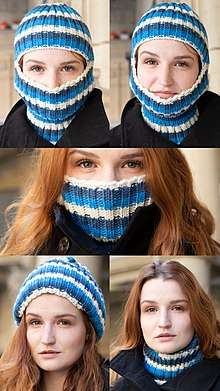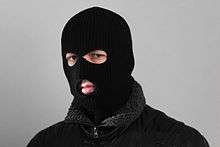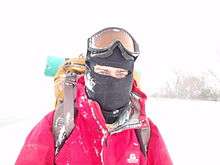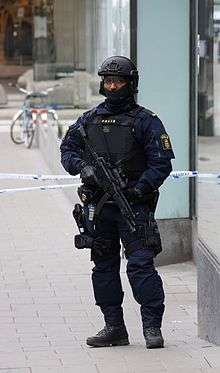Balaclava (clothing)
A balaclava, also known as a balaclava helmet or Bally (UK slang) or ski mask (US slang), is a form of cloth headgear designed to expose only part of the face, usually the eyes and mouth. Depending on style and how it is worn, only the eyes, mouth and nose, or just the front of the face are unprotected. Versions with a full face opening may be rolled into a hat to cover the crown of the head or folded down as a collar around the neck.


History
This type of headgear was known in the 19th century as an Uhlan cap or a Templar cap.[1]
The name comes from their use at the Battle of Balaclava during the Crimean War of 1854, referring to the town near Sevastopol in the Crimea,[2] where British troops there wore knitted headgear to keep warm.[3] Handmade balaclavas were sent over to the British troops to help protect them from the bitter cold weather. British troops required this aid, as their own supplies (warm clothing, weatherproof quarters, and food) never arrived in time.[4] According to Richard Rutt in his History of Handknitting, the name "balaclava helmet" was not used during the war but appears much later, in 1881.[1]
Uses
Warmth

Thin Balaclavas can be used under motorcycle or snowmobile helmets for warmth in cool or winter conditions.
Safety
Race drivers In Fédération Internationale de l'Automobile sanctioned events must wear balaclavas made of fire-retardant material underneath their crash helmets. In racing events, hill-climbs, special stages of rallies and selective sections of cross-country events entered on the International Sporting Calendar, all drivers and co-drivers must wear overalls as well as gloves (optional for co-drivers), long underwear, a balaclava, and shoes homologated to the FIA 8856-2000 standard.[5]
Military and police

In the Indian subcontinent, balaclavas are commonly referred to as monkey caps because of their typical earth tone colours, and the fact that they blot out most human facial features. Monkey caps sometimes have a small, decorative, woollen pom-pom on top. They are commonly worn by troops on Himalayan duty for protection from the cold.[6]
The United States Marine Corps has recently begun issuing balaclavas with hinged face guards as part of the Flame Resistant Organizational Gear program.[7][8]
In the Soviet Union, the balaclava became a part of standard OMON (special police task force) uniform as early as the Perestroyka years of the late 1980s. The original intent was to protect the identity of the officers to avoid intimidation from organized crime. Because of increased problems with organized crime of the 90s, TV shots of armed men in black balaclavas became common. Armed Russian police commonly conduct raids and searches of white-collar premises (typically in Moscow) while wearing balaclavas. Such raids have therefore come to be known in Russia as "maski shows", an allusion to a popular comic TV show of the 1990s.[9]
Concealment
Police in Kent confiscated a copy of the War on Terror board game partly because of the inclusion of a balaclava. Police spokesmen stated it "could be used to conceal someone's identity or could be used in the course of a criminal act."[10]
Balaclavas are often used by police battling drug cartels and gangs in Latin America to conceal their identity and protect their families.[11][12]
See also
- Anti-flash gear
- Anti-mask laws
- Facekini
- Knit cap
- Mask
- Neck gaiter
- Keffiyeh
References
- Richard Rutt, A History of Handknitting, London 1987, pages 134–5. (Note that there is a misprint in the date of the Battle of Balaclava, which took place 1854, in the original edition cited here)
- Games, Alex (2007). Balderdash & piffle : one sandwich short of a dog's dinner. London: BBC. ISBN 978-1-84607-235-2.
- Hartston, William. "Top 10 facts about the Crimean War". Daily Express. Express Newspaper. Retrieved March 6, 2018.
- Shepherd, John (1991). The Crimean Doctors: A History of the British Medical Services in the Crimean War. 1. Liverpool University Press. pp. 296–306.
- "Archived copy" (PDF). Archived from the original (PDF) on 2011-07-11. Retrieved 2009-06-24.CS1 maint: archived copy as title (link)
- Ghosh, Subir (2005) "Thanda lege jabey" Article in 19 Nov Hindusthan Times
- Archived October 29, 2012, at the Wayback Machine
- Archived September 16, 2012, at the Wayback Machine
- Kramer, Andrew E. (2011-08-31). "Memo to Exxon: Business With Russia May Involve Guns and Balaclavas". The New York Times.
- "Latest news from Cambridge & Cambridgeshire. Cambridge sports, Cambridge jobs & Cambridge business – War On Terror board game seized by police". Cambridge-news.co.uk. Archived from the original on 2012-08-06. Retrieved 2009-07-15.
- Sieff, Kevin (March 3, 2019). "It's so dangerous to police MS-13 in El Salvador that officers are fleeing the country". Washington Post.
- "Why anti-terror officers wear different clothes". BBC. November 18, 2015.
External links
